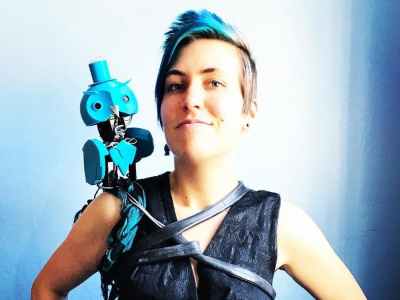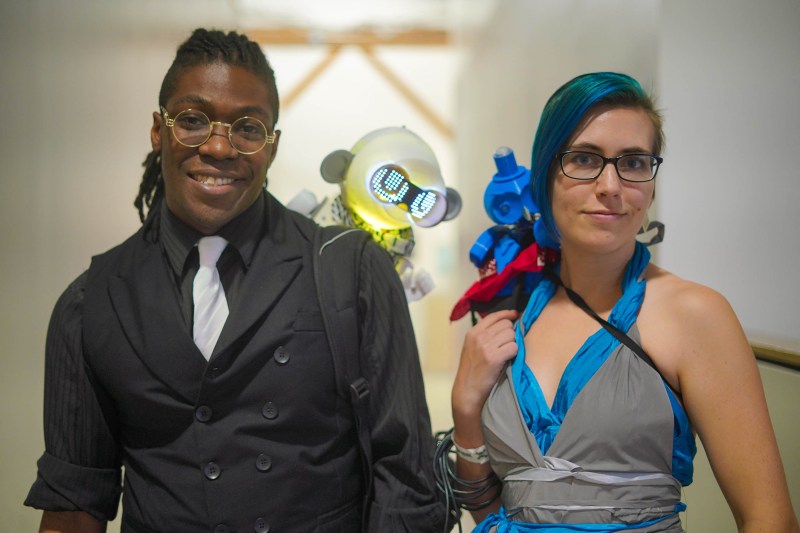Companion robots are a breed that, heretofore, we’ve primarily seen in cinema. Free from the limits of real-world technology, they manage to be charismatic, cute, and capable in ways that endear them to audiences the world over. Jorvon Moss and Alex Glow decided that this charming technology shouldn’t just live on the silver screen, and have been developing their own companion bots to explore this field. Lucky for us, they came down to Hackaday Superconference to tell us all about it!
The duo use a variety of techniques to build their ‘bots, infusing them with plenty of personality along the way. Jorvon favors the Arduino as the basis of his builds, while Alex has experimented with the Google AIY Vision Kit, BBC Micro:bit, as well as other platforms. Through clever design and careful planning, the two common maker techniques to create their unique builds. Using standard servos, 3D printed body parts, and plenty of LEDs, it’s all stuff that’s readily accessible to the home gamer.

Alex and Jorvon also talk about some of the pitfalls and challenges they’ve faced through the development of their respective companion bots. Jorvon defines a companion robot as “any robot that you can take with you, on any type of adventure”. Being out in the real world and getting knocked around means breakages are common, with both of the duo picking up handfuls of smashed plastic and bundles of wires at times. Thankfully, with 3D printing being the tool of the trade, it’s easy to iteratively design new components to better withstand the rough and tumble of daily life out and about. This also feeds into the rest of the design process, with Jorvon giving the example of Dexter’s last minute LED upgrades that were built and fitted while at Supercon.
Develop on companion bots is never really finished. Future work involves integrating Chirp.io data-over-sound communications to allow the bots to talk. There’s been some headaches on the software side, but we look forward to seeing these ‘bots chatting away in their own droid language. While artificial intelligence doesn’t yet have homebrew companion bots matching the wisecracking droids seen in movies, designing lifelike bodies for our digital creations is a big step in that direction. With people like Alex and Jolyon on the case, we’re sure it won’t be long before we’re all walking around with digital pals on our shoulders — and it promises to be fun!















Battlestar Galactica was ahead of it’s time.
Absolutely ….
The bots are pretty neat but I have a question about the effect on posture having a device sitting on one shoulder.
Even though they are light there appears to be a distinct misalignment in the shoulders of their human hosts.
Prolonged use could lead to physiological issues further down the track.
Just might need some consideration for future evolutions of the bots
Just wear one on each shoulder
:o)
Yea, one devil, one angel :-)
Pirates who habitually carried large parrots on their shoulders avoided neck and back problems in their dotage, by application of a government supplied neck straightening treatment usually known as a quick drop and a sudden stop.
One one treatment was needed for their necks to be corrected for the rest of their life!
Certainly a possible problem, on the other hand, people have been carrying purses for decades (and I am amazed at how much some of them weigh).
A lot of people are now hunched over a cell phone, with one arm raised in front of them for endless hours.
Text Neck Syndrome
Think it will be a while before sholder purching robots can compete with far more common ways we abuse our bodies.
Battlestar? What about Buck Rodgers in the 21st Century?
I completely missed the robot on the shoulder and thought one of the two people in the picture is one (i.e., a robot). I was ready to be impressed about how realistic and lifelike these things have become. (c:
Robots are nice, but I want a shoulder mounted animatronic raven…
https://www.youtube.com/watch?v=UCqkGoTgjMU
They look great, lots of fun, so please don’t take this in a negative way.
What I’d really like to read would be a clear articulation of the use case for these robots. Yes, I understand it is an entertainment device. I’d just like a more clear articulation.
Is it a social lubricant for extroverts to meet people? Is it an artistic declaration of one’s personal aesthetic? It is a type of smart watch that mounts to a different part of the body? Is it just something to bring to nerd parties? Is it a Normal repellent?
(“All of the above” doesn’t help, because the first one supercedes the rest.)
So for example, lets say I wanted to build one of these as a gift for somebody who has never seen one. How would I explain what it is in order to discuss with them the features they wanted?
One of the best early companion droids would be one that just follows you around and carries all your stuff for you. Think of how much that would help college professors who have to migrate from building to building between lectures.
reminds me of lucy and dic on youtube
https://www.youtube.com/watch?v=0ZetgiXy7w0
nsfw (language)
Begs question in how long the advances in the idea eventually lead to robot determining that humans convenient way to get around. Self healing , easily replicated by natural means, versatile, low energy sustainable, easily manipulated and trained when willing and of course disposable. The perfected weapons platform. Beasta of burden puts the yolk on all by itself. Already got a whole generation cant live without their robotic masters. Who needs legs? Just mount the cellphone on shoulder. Selfie sticks just early training method. Good human.